How to export Outlook account settings and passwords
If you are someone who is switching to a new computer and want to export your Outlook account settings and passwords from your old computer to your new computer, you have come to the right place. In this article, we explain how to easily export Outlook account settings and passwords using various methods.
But before we continue, we know that the failure of the Outlook platform is the most unpredictable, but at the same time it cannot be ignored. This may occur due to software glitches or hardware issues. To keep us safe, it is recommended to back up Outlook account settings before starting the export process.
Key Highlights
A. Export Outlook account settings and passwords using Microsoft tools and registry settings
- Office "Save My Settings" ”Wizard
- Recreate Outlook Profile
- Windows Easy Transfer
- Registry Settings
- Registry Editor
Export Outlook account settings and passwords using Microsoft tools and registry settings
Microsoft provides various tools to migrate or export account settings. Office Save My Setup Wizard, Windows Easy Transfer, and Registry Settings.
Follow the steps below to start the export process using the following strategies:
- Office "Save My Settings" Wizard: It is specifically designed to fix Outlook settings migration issues. The wizard has the property of backing up settings and then restoring them on the same system. However, it is version specific and does not achieve the desired performance.
- Re-create Outlook profiles: When the Outlook platform is damaged, Outlook profiles are discarded. Therefore, to prevent this issue, it is recommended to undergo manual recovery process for PST files and other items. However, this is a rather time-consuming process that requires a lot of patience from the user.
- Windows Easy Transfer: WET or Windows Easy Transfer is used to backup and migrate PST files and other account settings to a new system. However, the only limitation of this utility is that it may corrupt the address book. Therefore, it was not mentioned so quickly.
- Registry settings: It is recommended to use a batch file to export registry keys. Once completed, users can use Outlook macros to run Task Scheduler. Paste “REG EXPORT “HKEY_CURRENT_USER\Software\Microsoft\Office\15.0\Outlook” “C:\Users\Diane\My Box Files\Outlook-options.reg” /y” and run Task Scheduler.
-
Registry Editor: For direct export of Outlook settings, you can use Registry Editor. It exports Outlook settings to a .reg file, which can be later transferred and then imported into a new system Outlook application. The limitation it has is that it does not export password settings for Outlook files. Please follow the steps below to start the export process.
- Click the search bar and type Windows R to open the run command and type regedit.
- On the Registry Editor page, move to HKEY_CURRENT_USER\Software\Microsoft\Office\V.0\Outlook\Profiles and select the Profiles option and right-click Hit it. Click on the Export option.

- Next, provide a save location for the .reg file or Outlook settings and click Save Options.
- C Lost Registry Editor.
- Export this saved .reg file to a new computer system, then double-click this file to load it into the new Outlook application. Note: Please make sure that the Outlook account name, PST file location, and Outlook application version in the new system are the same as those in the old system.
The above method may take a long time to export your Outlook account settings and may also be tedious. You may also want to upgrade your Outlook version to a new system; in this case, we recommend using Remo Outlook Backup and Migration.
This tool is very convenient for ordinary Outlook users. Remo Outlook Backup and Migrate backs up, exports and migrates your entire Outlook data very securely in just a few clicks.
You can even easily move your Outlook profile to a new computer or from an older version of Outlook to a newer version of Outlook. This tool works smoothly on all versions of Outlook such as Outlook 2003, 2007, 2010, 2013, 2016, 2019, and 2021.
Read the next paragraph to learn how to export Outlook account using Remo Outlook Backup and Migrate.
Use software to export Outlook configuration files to a new computer (highly recommended)
To export Outlook settings or configurations on a new computer or transfer Outlook profiles from a computer to another computer, please download Remo Outlook Backup and Migration Tool on the computer from which you have to migrate Outlook, launch the application and follow the steps below:
- You will be on the home screen to see three different options; click on the Backup option.
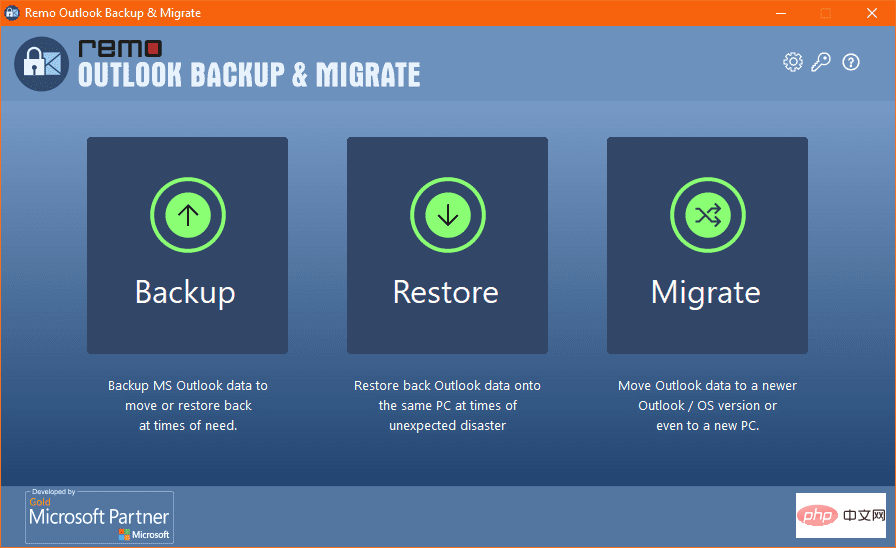
- On the next screen, you can choose between two different backup options depending on your needs.

Smart Backup: This feature will backup all Outlook properties.
Advanced Backup: This feature helps you select files to back up.
- After the backup process is complete, you can click View Report to verify the backed up data and then save the file to the desired location.
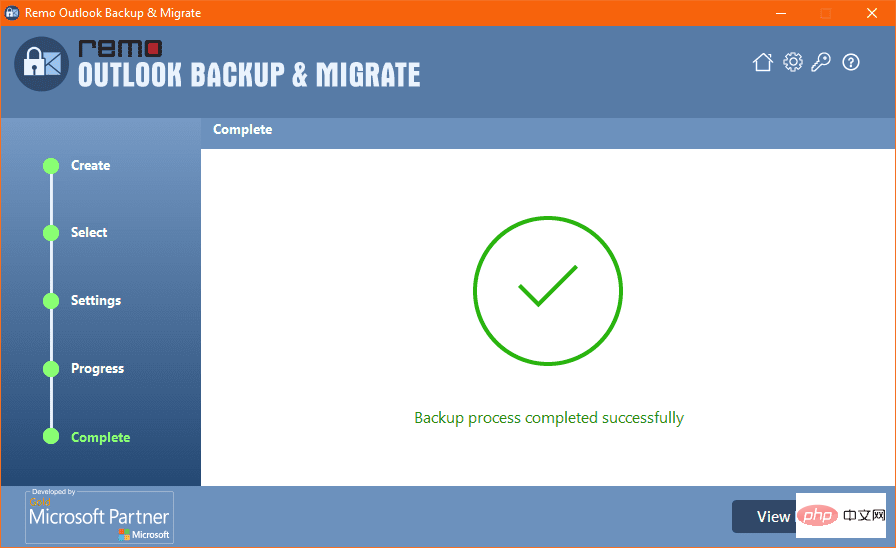
- If you want to move Outlook to another computer, you must copy the files from the USB drive to the new computer where you want to import the Outlook account .
Now, download and install the Remo Outlook Migration Tool on your new computer and follow these steps:
- Launch the tool and click Migrate.
- Browse the Outlook data file backup from your previous computer and click Next.
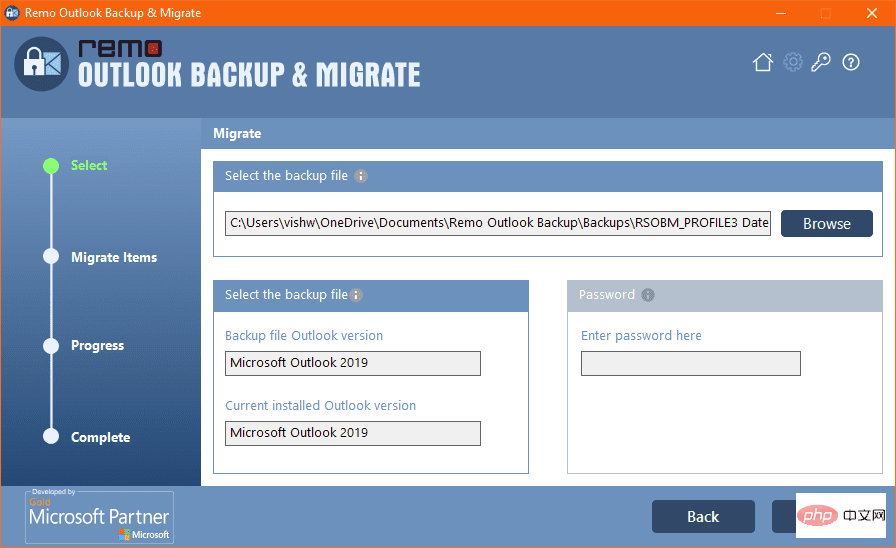
- Select the Outlook items you want to move to the new computer and click Next
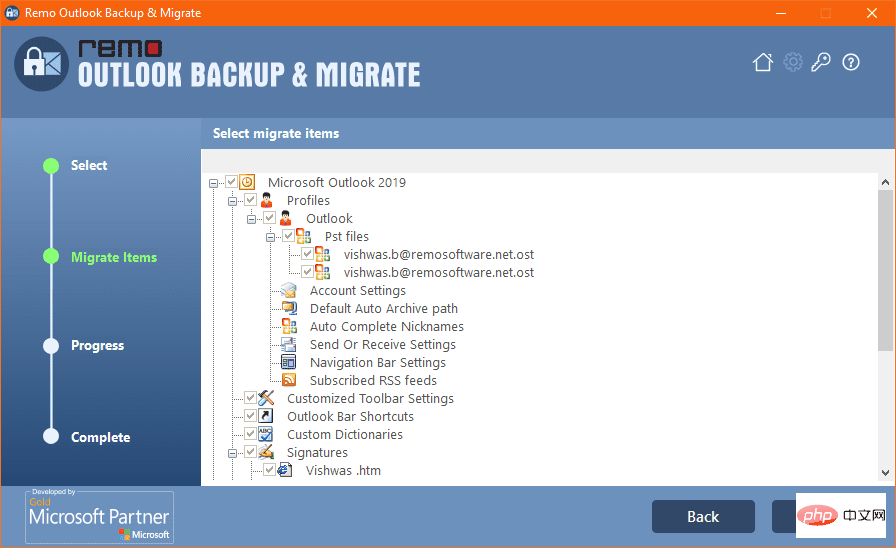
- After Outlook migration is complete, click Finish
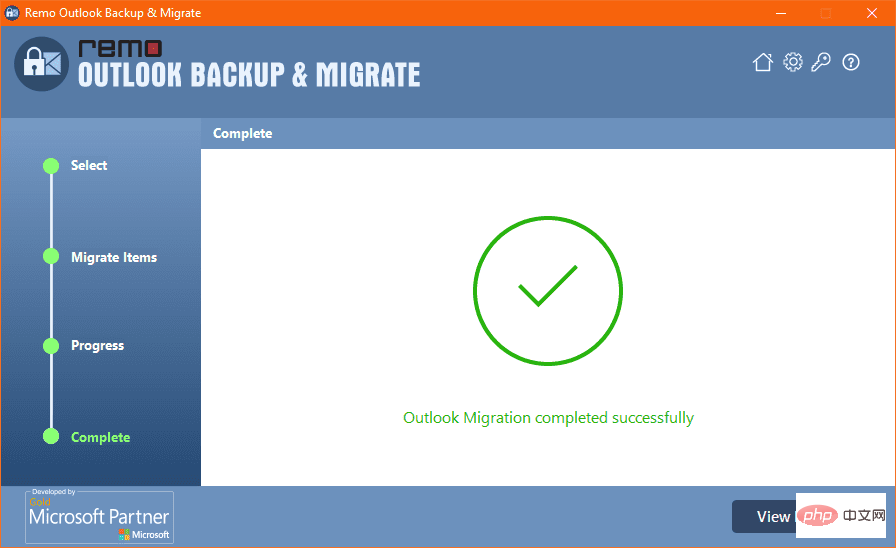
- # #Open the Outlook application on the new computer, click the
- Filetab, then open Account Settings Select the email account from the list and click
- Set as Default button to activate the profile.
The above is the detailed content of How to export Outlook account settings and passwords. For more information, please follow other related articles on the PHP Chinese website!

Hot AI Tools

Undresser.AI Undress
AI-powered app for creating realistic nude photos

AI Clothes Remover
Online AI tool for removing clothes from photos.

Undress AI Tool
Undress images for free

Clothoff.io
AI clothes remover

Video Face Swap
Swap faces in any video effortlessly with our completely free AI face swap tool!

Hot Article

Hot Tools

Notepad++7.3.1
Easy-to-use and free code editor

SublimeText3 Chinese version
Chinese version, very easy to use

Zend Studio 13.0.1
Powerful PHP integrated development environment

Dreamweaver CS6
Visual web development tools

SublimeText3 Mac version
God-level code editing software (SublimeText3)

Hot Topics
 What is the reason why PS keeps showing loading?
Apr 06, 2025 pm 06:39 PM
What is the reason why PS keeps showing loading?
Apr 06, 2025 pm 06:39 PM
PS "Loading" problems are caused by resource access or processing problems: hard disk reading speed is slow or bad: Use CrystalDiskInfo to check the hard disk health and replace the problematic hard disk. Insufficient memory: Upgrade memory to meet PS's needs for high-resolution images and complex layer processing. Graphics card drivers are outdated or corrupted: Update the drivers to optimize communication between the PS and the graphics card. File paths are too long or file names have special characters: use short paths and avoid special characters. PS's own problem: Reinstall or repair the PS installer.
 How to solve the problem of loading when PS is always showing that it is loading?
Apr 06, 2025 pm 06:30 PM
How to solve the problem of loading when PS is always showing that it is loading?
Apr 06, 2025 pm 06:30 PM
PS card is "Loading"? Solutions include: checking the computer configuration (memory, hard disk, processor), cleaning hard disk fragmentation, updating the graphics card driver, adjusting PS settings, reinstalling PS, and developing good programming habits.
 How to speed up the loading speed of PS?
Apr 06, 2025 pm 06:27 PM
How to speed up the loading speed of PS?
Apr 06, 2025 pm 06:27 PM
Solving the problem of slow Photoshop startup requires a multi-pronged approach, including: upgrading hardware (memory, solid-state drive, CPU); uninstalling outdated or incompatible plug-ins; cleaning up system garbage and excessive background programs regularly; closing irrelevant programs with caution; avoiding opening a large number of files during startup.
 Is slow PS loading related to computer configuration?
Apr 06, 2025 pm 06:24 PM
Is slow PS loading related to computer configuration?
Apr 06, 2025 pm 06:24 PM
The reason for slow PS loading is the combined impact of hardware (CPU, memory, hard disk, graphics card) and software (system, background program). Solutions include: upgrading hardware (especially replacing solid-state drives), optimizing software (cleaning up system garbage, updating drivers, checking PS settings), and processing PS files. Regular computer maintenance can also help improve PS running speed.
 Does mysql need the internet
Apr 08, 2025 pm 02:18 PM
Does mysql need the internet
Apr 08, 2025 pm 02:18 PM
MySQL can run without network connections for basic data storage and management. However, network connection is required for interaction with other systems, remote access, or using advanced features such as replication and clustering. Additionally, security measures (such as firewalls), performance optimization (choose the right network connection), and data backup are critical to connecting to the Internet.
 Is PS slow loading related to other programs that are running?
Apr 06, 2025 pm 06:03 PM
Is PS slow loading related to other programs that are running?
Apr 06, 2025 pm 06:03 PM
The secrets to mastering Office software include: understanding different versions and platforms, correctly installing and configuring, proficient in using the software interface, in-depth understanding of feature operations, application collaboration and sharing functions, utilizing templates and styles, mastering advanced skills, and solving common problems. In addition, you need to choose a version that suits your needs, make good use of templates and styles, develop backup habits, and learn shortcut keys and advanced techniques to improve efficiency.
 How to set color mode for export PDF on PS
Apr 06, 2025 pm 05:09 PM
How to set color mode for export PDF on PS
Apr 06, 2025 pm 05:09 PM
The secret to export PDFs with accurate colors: choose color mode according to the purpose: RGB for network display, CMYK for professional printing. Check Embed Profiles when exporting to maintain color consistency. Adjust compression settings to balance image quality and file size. For PDFs for networks, use RGB mode; for PDFs for printing, use CMYK mode.
 How to solve the problem of loading when the PS opens the file?
Apr 06, 2025 pm 06:33 PM
How to solve the problem of loading when the PS opens the file?
Apr 06, 2025 pm 06:33 PM
"Loading" stuttering occurs when opening a file on PS. The reasons may include: too large or corrupted file, insufficient memory, slow hard disk speed, graphics card driver problems, PS version or plug-in conflicts. The solutions are: check file size and integrity, increase memory, upgrade hard disk, update graphics card driver, uninstall or disable suspicious plug-ins, and reinstall PS. This problem can be effectively solved by gradually checking and making good use of PS performance settings and developing good file management habits.






